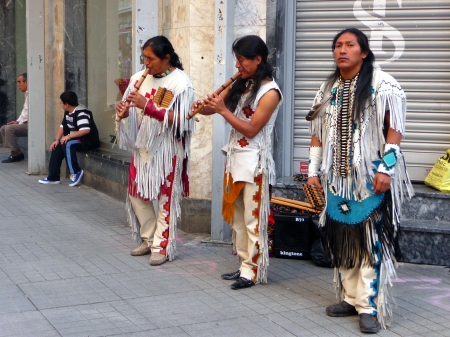


Having explored the possibility of a ‘French Connection’ in the first part of the Turkish Apache series, it’s time to investigate the most obvious hypothesis: a direct link between Turks and the Native American tribes, of which the Apaçi movement is the last incarnation. What? No, it’s not a joke.
The Turkish online world is full of theories claiming that the Native Americans have Turkic roots; ranging from the outright preposterous to the more or less credible ones. There are also books and TV programs devoted to the idea, which stokes the imagination of many Turkish citizens – particularly in nationalist circles – and even provokes the interest of some in the United States. Numerous Turkish-Native American conferences and meetings have been held, including one in New York in 2008 and another in Istanbul in 2010.
The debate has inspired hundreds upon hundreds of pages and forums in Turkish.
Just punch the question ‘Kızılderililer Türk mü?’ (Are Native Americans Turks?) into Google, and it becomes clear that the debate has inspired hundreds upon hundreds of pages and forums in Turkish. Comments stemming from a few copy-and-pasted articles appear in the thousands. The conclusions surely say more about the fascination of certain Turkish researchers with racial theories than they do about the seriousness of the methodologies employed. But how exactly could the Apaches be Turkish?
But how exactly could the Apaches be Turkish?
Among the scientific arguments, there’s both the ‘Sun Language Theory‘ and the ‘Turkish history thesis’, which was popular in the 1930s, the heyday of the Kemalist revolution. The ‘Sun Language Theory’ theory posits that the Turkish language is the origin of all languages in the world. According to the ‘Turkish history thesis’, it’s the Turkic peoples of Central Asia who through their migrations founded the brilliant civilisations of antiquity. These theories have found their way into both Turkish textbooks and official ideology, and have persisted up to the present. There are also theories set out by archaeologists, according to which the first American Indians migrated from Siberia via the Bering Strait during the Ice Age (between 20,000 and 10,000 BC). The fact that the regions of origin are convergent is the central argument in support of the Turkic roots of American Indians.
Notorious ultra-nationalist, pan-Turkist and former Columbia University professor, the late Reha Oğuz Türkkan (1920-2010) helped popularise the theory of Turkish American Indians through his 1999 book ‘Kızılderililer ve Türkler‘ (Native Americans and Turks). The popular Turkish western film ‘Yahşi Batı” (The Wonderful West) from 2010 features two representatives of the Ottoman Empire traversing the Wild West. In one scene, the famous comedian Cem Yılmaz calls to his inhospitable Native cousins: “We come from Istanbul, where we say that the Indians are Turks. […] And if we say that, you have the salutations of Apaçi Selim from Kasımpaşa [a neighbourhood in Istanbul]?”
“We come from Istanbul, where we say that the Indians are Turks. […] And if we say that, you have the salutations of Apaçi Selim from Kasımpaşa [a neighbourhood in Istanbul]?”
Reha Oğuz Türkkan died in 2010, so he never got to see the expansion of the Anatolian Apaches. But, having watched Westerns and read French and Turkish historical novels since childhood, he was convinced of the Turkish ancestry of American Indians. From an early age, he had made up his mind to run away from home and cross the Asian continent in order to rescue his cousins from the wicked cowboys. That project didn’t materialise, but a 1934 meeting with Atatürk in Büyükada, Istanbul, would confirm his belief. While discussing the Gagaouz origins of Türkkan’s classmates, the Turkish leader said to him: “They still speak Turkish … There are other peoples to which we are related – the Hungarians, for example, or the Native Americans.” Mustafa Kemal seems to have forgotten that the American continent was inhabited by a mosaic of very different peoples prior to the arrival of European settlers.
Atatürk paid serious attention to the American Indian question.
Yet Atatürk paid serious attention to the American Indian question. He sent the historian Tahsin Mayatepek to Mexico as the Turkish Ambassador in order to research the Turkic origins of the Maya, along with the mysterious continent of Mu, another pet interest of the founder of the Turkish Republic.
Based on the work of European linguists like Georges Dumézil on the Quechua, ‘Turkic Origins’ proponents point to similarities between some Turkish and Native American words, including ‘ata’ (father) and ‘ana’ (mother). The ancient Turks and Native Americans also share common spiritual practices: shamanism and the cult of the sun. Some authors also see parallels in myth and culture, including common motifs in carpets or similar kinds of music. DNA tests would serve to strengthen the hypothesis that Native Americans have Turkic origins, but so far it hasn’t gained widespread acceptance among researchers.
Some authors also see parallels in myth and culture, including common motifs in carpets or similar kinds of music.
Accuracy set aside, this research has also sparked intercultural encounters, which are unusual to say the least. Brent Kennedy, a Melungeon researcher documented this in his book From Anatolia to Appalachia: A Turkish-American Dialogue. “Since 1995, hundreds of children in Appalachian Virginia, Tennessee and Kentucky, have acquired Turkish pen pals […]. A myriad of cultural exchanges are underway and it’s no longer an unusual sight to see native Turkish musicians jamming and dancing with traditional fiddlers and Appalachian singers.”
According to Kennedy, his people are the descendants of Ottoman Turkish slaves who landed in the New World with Sir Francis Drake during the sixteenth century. The origin of the Melungeons is an issue arousing fierce controversy in the US blogosphere. There are accusations that the community’s leadership, as well as the Turkish lobby in Washington, are exploiting the Melungeons for the benefit of Ankara’s political agenda. But in the end, all this has taken us far away from Anatolia and its slick and dancing Apaches.


